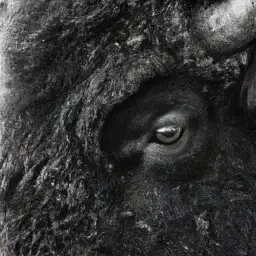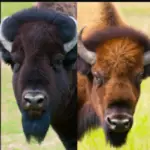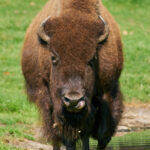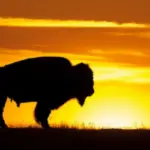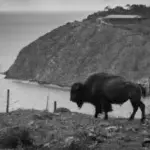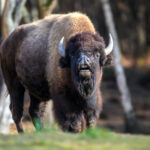Have you ever wondered what sound a bison makes? Look no further than the fascinating product “What Sound Does A Bison Make.” This unique and engaging offering provides an immersive experience, allowing you to discover the distinctive sounds these majestic creatures produce. Delve into the world of bison with this captivating product and gain a deeper understanding of their communication and behavior through the power of sound. Get ready to embark on a journey of discovery like no other.
Understanding bison behavior and communication
Bison, also known as American buffaloes, are fascinating creatures with complex behavior patterns and communication methods. As with many animal species, vocalization plays a significant role in their communication. By understanding their vocalizations, we can gain insights into their behavior, hierarchy, and even their reproductive patterns.
Importance of vocalization in animal communication
Vocalization is crucial for animals to communicate their needs, emotions, warnings, and mating intentions. Bison, being highly social animals, rely on vocalization to maintain contact with other members of their herd, signal danger, establish dominance, and attract mates during breeding season. These vocal signals allow bison to coordinate their movements, ensure herd cohesion, and ensure the survival and reproduction of their species.
General behavior traits of bison
Bison exhibit various behavior traits that are important to understand when deciphering their vocalizations. They are highly social animals that form hierarchical herds led by dominant males, also known as bulls. Female bison, known as cows, often form smaller family groups within the herd. Understanding these social dynamics helps us interpret the significance of their vocalizations.
Types of sounds made by bison
Bison produce a range of sounds to convey different messages in their communication. These vocalizations can be categorized into distinct types, each serving a specific purpose.
Groaning and grunting
Gentle groaning and grunting sounds are common among bison herds and often indicate contentment or a non-threatening situation. These low-frequency sounds contribute to an overall calm and harmonious atmosphere within the group.
Roaring and bellowing
Roaring and bellowing are powerful, deep sounds emitted by dominant male bison during the mating season. These calls serve as a declaration of their strength, establishing dominance and attracting potential mates. The resonance of the roars can travel significant distances, ensuring that their intentions are heard throughout the surrounding region.
Snorting sounds
Snorting is a sound produced by bison when they sense danger. It serves as a warning to the rest of the herd, alerting them to potential threats such as predators or approaching humans. Snorting is accompanied by a distinct puffing sound, emphasizing the urgency and seriousness of the danger.
Subtle sounds made by bison
In addition to the more prominent vocalizations, bison also make subtle sounds that convey specific messages within their social interactions. These include soft grunts during grooming sessions, gentle whining to communicate with their calves, and quick exhales during playful encounters. While these sounds may be less noticeable, they play a vital role in maintaining social bonds and ensuring effective communication within the herd.
The deciphering of bison sounds
Understanding bison vocalizations requires deciphering their vocabulary, taking into account sound pitch, volume, and frequency. While individual bison may have unique variations in their vocalizations, certain patterns and meanings can be identified.
Understanding bison vocabulary
By observing patterns in bison vocalizations over time, researchers have been able to identify a vocabulary of sorts. For example, a series of snorts followed by grunts may indicate a warning of imminent danger. Similarly, a combination of deep roars and bellows during the mating season signifies dominance and the intention to attract mates.
Role of sound pitch and volume
Sound pitch and volume play crucial roles in bison communication. Deeper and louder sounds, such as the roars of dominant males, convey power and dominance. Conversely, softer and higher-pitched sounds are often associated with more submissive behaviors or non-threatening situations, allowing for a complex range of communication within the herd.
Interpreting the frequency of bison sounds
The frequency at which bison vocalize can also provide valuable information about their behavior. For example, during the mating season, the frequency of roars and bellows increases significantly as bulls compete for mates and establish their dominance. Understanding and interpreting these changes in frequency allows us to gain insights into the bison’s reproductive dynamics and the interactions between individuals within the herd.
Bison vocalization during mating season
During the mating season, bison vocalizations undergo significant changes as they compete for mates and establish their dominance. These shifts in vocal behavior are crucial for understanding their reproductive patterns and behaviors.
Changes in bison sounds during mating season
As the mating season approaches, the vocalizations of male bison become more frequent, intense, and prolonged. The deep roars and powerful bellows of dominant bulls resonate across the landscape, attracting both females and challenging rival males. Understanding these changes in vocal behavior helps us track the reproductive success of individual males and monitor the overall health of the bison population.
Interpreting bison roars during mating
The roars emitted by dominant males during the mating season serve multiple purposes. They communicate their strength, announce their presence to potential mates, and warn other males to stay away. The intensity and duration of these roars can indicate the level of competition and dominance within the herd. By interpreting these signals, researchers can gain valuable insights into the structure of the bison population and the success of individual bulls in attracting mates.
Role of sound in attracting mates
The vocalizations of both male and female bison play a crucial role in attracting mates during the breeding season. Females emit soft, high-pitched whines to signal their fertility and availability to males. These vocal signals help males identify receptive females, establish breeding pairs, and ensure successful reproduction within the herd. By studying these mating vocalizations, researchers can better understand the dynamics of bison reproduction and the factors that contribute to healthy populations.
Bison sounds communication to their offspring
Bison use vocalizations not only to communicate with their peers but also to guide and bond with their offspring. The delicate mother-calf vocalizations and other sounds within the herd contribute to the overall cohesion and well-being of the bison population.
The use of sound in guiding calves
Mother bison use a variety of vocalizations to guide and protect their calves. Soft grunts and whines help establish a bond between mother and calf, ensuring that they stay close to each other within the herd. These vocal cues play a vital role in the survival and well-being of the calves, teaching them to navigate the environment and providing a sense of security.
Interpreting the mother-calf vocalization
The vocalizations between mother and calf are essential for maintaining a close relationship and ensuring herd cohesion. By closely observing and interpreting these interactions, researchers can gain insights into the emotional bond between mother and calf, the protective behaviors exhibited by mothers, and the development of communication skills in young bison.
Role of vocalization in bison herd cohesion
Vocalization is a fundamental tool for establishing and maintaining cohesion within a bison herd. The exchange of vocal cues between individuals helps coordinate group movements, communicate danger, and establish social bonds. The absence of vocalizations can indicate disruptions in the herd’s social structure or potential threats to its well-being. By studying the role of vocalization in herd cohesion, researchers can contribute to the conservation and management of bison populations, ensuring their long-term survival.
Environment’s influence on bison sounds
The environment, including temperature, weather conditions, and specific habitats, has a significant influence on bison vocalizations. Understanding these environmental factors helps us interpret and appreciate the nuances of their communication.
How different environmental conditions affect bison sounds
Various environmental factors influence the production and transmission of bison sounds. For instance, in windy conditions, the sound of bison vocalizations may be carried further, allowing them to communicate with larger distances. Similarly, changes in humidity and temperature can affect the acoustic qualities of their calls. By considering these environmental variables, researchers can differentiate between variations caused by external factors from those that indicate changes in behavior or intent.
Effects of temperature and weather on bison vocalization
Temperature and weather conditions play a crucial role in the modulation and audibility of bison vocalizations. In colder temperatures, bison may produce deeper and more resonant sounds as the density of the air affects the propagation of sound waves. Additionally, weather patterns such as rain or snow can influence the overall clarity and range of bison vocalizations. By studying the effects of temperature and weather, researchers can gain insights into the adaptability of bison to different environments and their ability to communicate effectively under varying conditions.
Sound adaptations to specific environments
Bison have evolved unique adaptations to specific environments, including their vocalizations. Different populations of bison residing in diverse habitats may exhibit variations in vocalizations to optimize their communication in specific conditions. By examining these adaptations, scientists can gain insights into the evolutionary processes and ecological dynamics that have shaped the vocal repertoire of bison populations worldwide.
How humans interpret bison sounds
Humans face unique challenges when interpreting bison sounds due to variations in vocalizations and the limited ability to communicate directly with these animals. Researchers employ various methods, including research studies and technological advancements, to uncover the meanings and significance behind these vocalizations.
Challenges in understanding bison sounds
One of the primary challenges in understanding bison sounds is the limited understanding of their vocal repertoire and the context-specific variations within different populations. Additionally, the relatively low population densities of bison in some areas make it difficult to observe and record their vocalizations accurately. Overcoming these challenges requires long-term field studies, collaborative research, and continuous monitoring of bison populations.
Research and studies on bison vocalization
Researchers have undertaken numerous studies to delve deeper into the intricacies of bison vocalizations. By observing and documenting the vocal behaviors of bison populations from various regions, researchers have been able to identify patterns and meanings behind their vocalizations. Collaborative efforts among scientists, behavioral ecologists, and acoustic specialists have facilitated a greater understanding of bison communication and behavior.
Use of technology in studying bison sounds
Advancements in technology have significantly contributed to the study of bison vocalization. Acoustic monitoring devices, such as bioacoustic recorders and sound analysis software, allow researchers to capture and analyze vocalizations in a non-invasive manner. These technological tools provide valuable data on the call patterns, frequency variations, and behavioral contexts associated with bison vocalizations. Integrating traditional field observations with cutting-edge technology helps enhance our understanding of bison sounds and their implications for population management and conservation efforts.
Differences in Bison sounds and those of similar species
While bison vocalizations share similarities with other bovines, they also possess unique characteristics that distinguish them from other species. Understanding the differences in vocalizations aids in accurately identifying bison and contributes to the broader understanding of their communication systems.
Comparison with sounds from other bovines
Bison share common ancestry with other bovines, such as cattle and buffalo species across the globe. As a result, some vocalizations may exhibit similarities or overlap with their relatives. However, by examining key differences in vocal patterns, frequencies, and contexts, researchers can differentiate bison sounds from those produced by other bovine species.
Unique aspects of bison vocalization
Bison vocalizations possess unique qualities that set them apart from other species. These characteristics include the deep, resonant roars of dominant males during the mating season, the soft and high-pitched whines of female bison during courtship, and the subtle vocal cues used to guide and communicate with their offspring. Recognizing these distinctive aspects enables researchers to accurately identify and monitor bison populations, contributing to their conservation and management.
Differentiating bison sounds from others
Differentiating bison sounds from those of other species can be challenging but crucial for accurate species identification. By carefully observing the specific qualities, frequencies, and behavior-associated contexts of bison vocalizations, experts can distinguish them from other similar-sounding vocalizations. This differentiation aids in accurately studying, monitoring, and protecting bison populations, ensuring their survival for future generations.
Preservation and conservation of the bison species
Understanding bison vocalizations is vital for the preservation and conservation of these magnificent creatures. By recognizing the role of vocalization in their survival, we can develop effective strategies to protect and conserve bison populations worldwide.
Role of vocalization in bison preservation
Vocalization plays a significant role in maintaining bison populations and preserving their natural behaviors. By recognizing the importance of vocal cues for communication, herd cohesion, and reproductive success, conservationists can implement management strategies that prioritize the preservation of bison vocalization within their natural habitats. Protecting the integrity of their vocal communication ensures the overall health and sustainability of the species.
How understanding bison sounds contributes to their survival
Understanding bison sounds provides us with essential insights into their behavior, social structures, and reproductive dynamics. By studying their vocalizations, researchers can develop comprehensive conservation plans that address the specific needs and challenges faced by bison populations. This knowledge allows for the implementation of targeted measures to protect their habitats, manage the impacts of human activities, and promote the long-term survival of bison species worldwide.
Implications of bison vocalization study to conservation efforts
The study of bison vocalizations has numerous implications for conservation efforts. Insights gained from deciphering their vocalizations aid in monitoring changes in behavior, identifying potential threats, and evaluating the overall health and well-being of bison populations. This knowledge enables conservationists to make informed decisions, establish protected areas, and implement sustainable management practices that promote the survival of bison species as keystone creatures within their ecosystems.
What is the Bison’s Vocalization Like in Relation to Their Population in the US?
The number of American bison in the US has a direct impact on their vocalization. With a dwindling population in the past, their vocalization was less frequent. However, conservation efforts have seen an increase in their numbers, leading to more vocalization within the herds across the country.
The cultural significance of bison sounds
Bison vocalizations have profound cultural significance, serving as a source of inspiration, symbolism, and connection for indigenous cultures and contemporary society alike. Their sounds have been woven into various forms of art, music, and storytelling throughout history.
Symbolic meanings of Bison sounds in indigenous cultures
In indigenous cultures, bison vocalizations hold deep spiritual and symbolic meanings. The powerful roars and bellows of dominant males during the mating season represent strength, courage, and virility. These sounds have been revered and incorporated into spiritual rituals, tribal ceremonies, and traditional stories, symbolizing the interconnectedness between humans, animals, and nature.
Use of bison sounds in music and art
Bison vocalizations, with their distinctive qualities and evocative nature, have inspired artists and musicians across cultures. The resonant roars and haunting whines have been captured and recreated through diverse artistic mediums, from paintings and sculptures to musical compositions. These creative expressions not only celebrate the unique sounds of bison but also foster a deeper connection between humans and the natural world.
Impacts of cultural interpretations on understanding bison vocalization
Cultural interpretations of bison vocalizations contribute to our overall understanding and appreciation of these sounds. Indigenous knowledge and perspectives provide valuable insights into the spiritual, ecological, and cultural significance of bison vocalizations. Integrating these diverse perspectives with scientific research enriches our understanding of bison communication and reinforces the importance of preserving their vocal traditions for future generations.
In conclusion, understanding bison behavior and communication requires a comprehensive understanding of their vocalizations. By deciphering the different types of sounds made by bison, interpreting their meanings, considering environmental influences, and exploring their cultural significance, we can unlock the secrets of their communication. This knowledge is vital for the preservation and conservation of bison species and enables us to appreciate the remarkable complexities of their social interactions and their harmonious place in the natural world.

